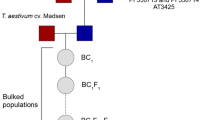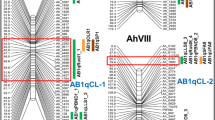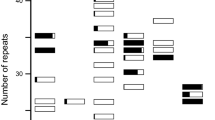Abstract
Although unadapted germplasms have been used to improve disease and insect resistance in alfalfa, there has been little effort to use these for improving forage yield. We evaluated genetic diversity and combining ability among two unadapted germplasms (Medicago sativa ssp. sativa Peruvian and M. sativa ssp. falcata WISFAL) and three Northern U.S. adapted alfalfa cultivars. Population structure analyses indicated that the WISFAL and Peruvian germplasms were genetically distinct from the cultivars, although Peruvian was relatively closer to the cultivars. Peruvian and WISFAL germplasms were intermated to generate a novel hybrid population. This population was crossed to the three cultivars as testers, and the testcross progenies were evaluated for forage yield along with the hybrid population, the original germplasms (Peruvian, WISFAL and cultivars), testcrosses of Peruvian and WISFAL to the three cultivars and a three-way hybrid of the cultivars. The experiment was carried out in the field in Temuco, Chile and Arlington, Wisconsin, USA, and forage was harvested during two seasons. Results from these evaluations showed that hybrids between the Peruvian × WISFAL population and the cultivar testers yielded as much as the cultivar testers. Heterosis was observed between Peruvian and WISFAL, and between these germplasms and the cultivar testers, suggesting that each germplasm may contain different favorable alleles. If Peruvian and WISFAL populations contain alleles at different loci that complement cultivar testers, then combining and enriching these alleles in a single population could result in improved combining ability with alfalfa cultivars.



Similar content being viewed by others
References
Barnes DK, Bingham ET, Murphy RP, Hunt OJ, Beard DF, Skrdla WH, Teuber LR (1977) Alfalfa germplasm in the United States: genetic variability, use and maintenance. USDA-ARS Tech Bull 1571, Hyattsville, Md.
Bingham ET (1980) Maximizing heterozygosity in autopolyploids. In: Lewis WH (ed) Polyploidy: biological relevance. Plenum, New York, pp 471–491
Bingham ET (1990) Backcrossing tetraploidy into diploid Medicago falcata L. using 2n eggs. Crop Sci 30:1353–1354
Bingham ET (1993) Registration of WISFAL alfalfa (Medicago sativa ssp. falcata) tetraploid germplasm derived from diploids. Crop Sci 33:217–218
Bingham ET, Groose RW, Woodfield DR, Kidwell KK (1994) Complementary gene interactions in alfalfa are greater in autotetraploids than diploids. Crop Sci 34:823–829
Bonierbale MW, Plaisted RL, Tanksley SD (1993) A test of the maximum heterozygosity hypothesis using molecular markers in tetraploid potatoes. Theor Appl Genet 86:481–491
Brummer EC, Cazcarro PM, Luth D (1999) Ploidy determination of alfalfa germplasm accessions using flow cytometry. Crop Sci 39:1202–1207
Brummer EC, Kochert G, Bouton JH (1991) RFLP variation in diploid and tetraploid alfalfa. Theor Appl Genet 83:89–96
Busbice TH, Wilsie CP (1966) Inbreeding depression and heterosis in autotetraploids with application to Medicago sativa L. Euphytica 15:52–67
Crochemore ML, Huyghe C, Ecalle C, Julier B (1998) Structuration of alfalfa genetic diversity using agronomic and morphological characteristics. Relationship with RAPD markers. Agronomie 18:79–94
Cress CE (1966) Heterosis of the hybrid related to gene frequency differences between two populations. Genetics 53:269–274
Demment MW, Teuber LR, Bourque DP, Phillips DA (1986) Changes in forage quality of improved alfalfa populations. Crop Sci 26:1137–1143
Diwan N, Bouton JH, Kochert G, Creagan PB (2000) Mapping of simple sequence repeat (SSR) DNA markers in diploid and tetraploid alfalfa. Theor Appl Genet 101:165–172
Dudley JW, Busbice TH, Levings III CS (1969) Estimates of genetic variance in Cherokee alfalfa (Medicago sativa L.). Crop Sci 9:228–231
Dunbier MW, Bingham ET (1975) Maximum heterozygosity in alfalfa: results using haploid-derived autotetraploids. Crop Sci 15:527–531
Duvick DN (1984) Genetic contribution to yield gains of U.S. hybrid maize, 1930 to 1980. In: Fehr WR (ed) Genetic contributions to yield gains of five major crop plants. Special publication no. 7. ASA, CSSA, and SSSA Madison, pp 15–47
Falush D, Stephens M, Pritchard JK (2003) Inference of population structure II. Linked and correlated allele frequencies. Genetics (in press)
Forsthoefel NR, Bohnert HJ, Smith SE (1992) Discordant inheritance of mitochondrial and plastid DNA in diverse alfalfa genotypes. J Hered 83:342–345
Groose RW, Kojis WP, Bingham ET (1988) Combining ability differences between isogenic diploid and tetraploid alfalfa. Crop Sci 28:7–10
Groose RW, Talbert LE, Kojis WP, Bingham ET (1989) Progressive heterosis in autotetraploid alfalfa: studies using two types of inbreeds. Crop Sci 29:1173–1177
Hill RR Jr, Kalton RR (1976) Current philosophies in breeding for yield. In: Barnes DK (ed) Rep 25th Alfalfa Improv Conf. USDA-SEA, Peoria, Ill., p 51
Hill RR Jr, Shenk JS, Barnes RF (1988) Breeding for yield and quality. In: Hanson AA, Barnes DK, Hill RR (eds) Alfalfa and alfalfa improvement. Agronomy Monograph no. 29. ASA, CSSA, and SSSA, Madison, Wis., pp 809–825
Holland JB, Bingham ET (1994) Genetic improvement for yield and fertility of alfalfa cultivars representing different eras of breeding. Crop Sci 34:953–957
Joliffe IT (1986) Principal components analysis. Springer Verlag, Berlin Heidelberg, New York
Jones JS, Bingham ET (1995) Inbreeding depression in alfalfa and cross-pollinated crops. Plant Breed Rev 13:209–233
Kehr W, Gardner RCO (1960) Genetic variability in Ranger alfalfa. Agron J 52:41–44
Kidwell KK, Osborn TC (1992) Simple plant DNA isolation procedures. In: Beckman J, Osborn TC (eds) Plant genomes: methods for genetic and physical mapping. Kluwer, Dordrecht, pp 1–13
Kidwell KK, Austin DF, Osborn TC (1994a) RFLP evaluation of nine Medicago accessions representing the original germplasm sources for the North American alfalfa cultivars. Crop Sci 34:230–236
Kidwell KK, Woodfield DR, Bingham ET, Osborn TC (1994b) Molecular marker diversity and yield of isogenic 2× and 4× single-crosses of alfalfa. Crop Sci 34:784–788
Kidwell KK, Hartweck LM, Yandell BS, Crump PM, Brummer JE, Moutray J, Osborn TC (1999) Forage yields of alfalfa populations derived from parents selected on the basis of molecular marker diversity. Crop Sci 39:223–227
Kimbeng CA, Bingham ET (1998a) Population improvement in alfalfa: fertility and S1 forage yield performance in original and improved populations. Crop Sci 37:1509–1513
Kimbeng CA, Bingham ET (1998b) Population improvement in lucerne (Medicago sativa L.): components of inbreeding depression are different in original and improved populations. Aust J Exp Agric 38:831–836
Kimbeng CA, Bingham ET (1999) Population improvement in lucerne (Medicago sativa L.): genetic analyses in original and improved populations. Aust J Exp Agric 39:549–554
Lesins K, Lesins I (1964) Diploid Medicago falcata L. Can J Genet Cytol 6:152–163
Melton B, Currier C, Kimmel J (1990) Registration of alfalfa germplasm representing eight diversity groups and a very fall dormant population. Crop Sci 30:753–754
Miller FR, Kebede Y (1984) Genetic contributions to yield gains in sorghum, 1950 to 1980. In: Fehr WR (ed) Genetic contributions to yield gains of five major crop plants. Special publication no. 7. ASA, CSSA, and SSSA, Madison, Wis., pp 1–14
Moll RH, Salhuana WS, Robinson HF (1962) Heterosis and genetic diversity in variety crosses of maize. Crop Sci 2:197–198
Musial JM, Basford KE, Irwin JAG (2002) Analysis of genetic diversity within Australian Lucerne cultivars and implications for future genetic improvement. Aust J Agric Res 53:629–633
Paterniani E, Lonnquist JH (1963) Heterosis in interracial crosses of corn (Zea mays L.). Crop Sci 3:504–507
Pfeiffer TW, Bingham ET (1983) Improvement of fertility and herbage yield by selection within two-allele populations of tetraploid alfalfa. Crop Sci 23:633–636
Pritchard JK, Stevens M, Donnelly P (2000) Inference of population structure using multilocus genotype data. Genetics 155:945–959
Quiros CF (1982) Tetrasomic segregation for multiple alleles in alfalfa. Genetics 101:117–127
Riday H, Brummer EC (2002) Forage yield heterosis in alfalfa. Crop Sci 42:716–723
Riday H, Brummer EC, Campbell TA, Luth D, Cazcarro P (2003) Comparisons of genetic and morphological distance with heterosis between Medicago sativa ssp. sativa and falcata. Euphytica 131:37–45
Rolf FJ (2000) Numerical taxonomy and multivariate analysis system, version 2.1. Exeter Software, New York
Rowe DE, Hill RR Jr (1981) Inter-population improvement procedures for alfalfa. Crop Sci 21:392–397
Rumbaugh MD, Caddel JL, Rowe DE (1988) Breeding and Quantitative genetics. In: Hanson AA, Barnes DK, Hill RR (eds) Alfalfa and alfalfa improvement. Agronomy monograph no. 29. ASA, CSSA, and SSSA, Madison, Wis., pp 777–807
Rusche ML, Mogensen HL, Zhu T, Smith SE (1995) The zygote and proembryo of alfalfa: quantitative, three-dimensional analysis and implications for biparental plastid inheritance. Protoplasma 189:88–100
SAS Institute (2001) SAS/STAT users guide, ver. 8.02. SAS Institute, Cary, N.C.
Seah S, Sivasithamparam K, Karakousis A, Lagudah ES (1998) Cloning and characterization of a family of disease resistance gene analogs from wheat and barley. Theor Appl Genet 97:937–945
Sokal RR, Rohlf FJ (1995) Biometry. Freeman, New York
Sriwatanapongse S, Wilsie CP (1968). Intra- and intervariety crosses of Medicago sativa L. and Medicago falcata L. Crop Sci 8:465–466
Stanford EH (1951) Tetrasomic inheritance in alfalfa. Agron J 43:222–225
Sumberg JE, Murphy RP, Lowe CC (1983) Selection for fiber and protein concentration in a diverse alfalfa population. Crop Sci 23:11–14
Waldron LR (1920) First generation crosses between two alfalfa species. J Am Soc Agron 12:133–143
Westgate JM (1910) Variegated alfalfa. USDA Bureau Pl Ind Bull 169
Wijk AJP van, Reheul D (1991) Achievements in fodder crops breeding in maritime Europe. In: Proc 16th Meet Fodder Crops Section Eucarpia. PUDOC, Wageningen, pp 13–18
Woodfield DR, Caradus JR (1994) Genetic gain in white clover representing six decades of plant breeding. Crop Sci 34:1205–1213
Woodfield DR, Bingham ET (1995) Improvement in two-allele autotetraploid populations of alfalfa explained by accumulation of favorable alleles. Crop Sci 35:988–994
Wright S (1951) The genetical structure of populations. Ann Eugen 15:323–354
Wright S (1965) The interpretation of population structure by F-statistics with special regard to systems of mating. Evolution 19:395–420
Zhu T, Mogensen HL, Smith SE (1993) Quantitative, three dimensional analysis of alfalfa egg cells in two genotypes: implications for biparental plastid inheritance. Planta 190:143–150
Acknowledgements
We thank E.T. Bingham and Amorntip Muangprom for comments on the manuscript. Support was provided by a USDA Hatch grant from the University of Wisconsin, College of Agricultural and Life Sciences.
Author information
Authors and Affiliations
Corresponding author
Additional information
Communicated by H.C. Becker
Rights and permissions
About this article
Cite this article
Maureira, I.J., Ortega, F., Campos, H. et al. Population structure and combining ability of diverse Medicago sativa germplasms. Theor Appl Genet 109, 775–782 (2004). https://doi.org/10.1007/s00122-004-1677-x
Received:
Accepted:
Published:
Issue Date:
DOI: https://doi.org/10.1007/s00122-004-1677-x




